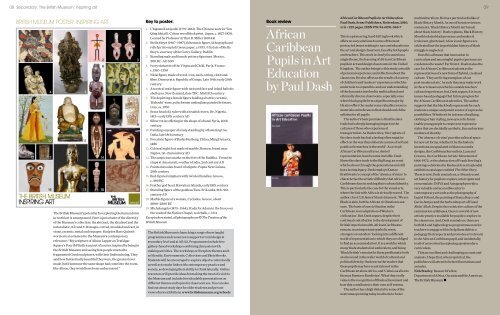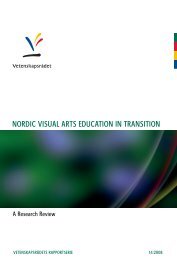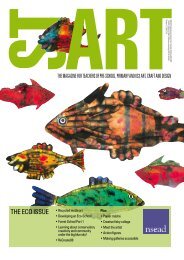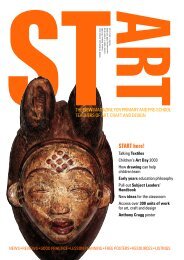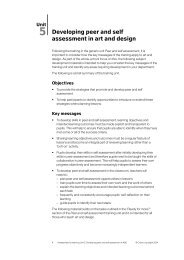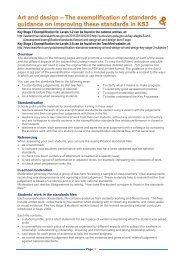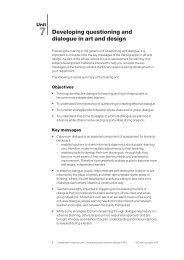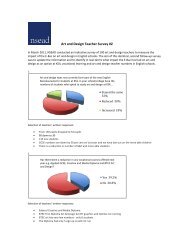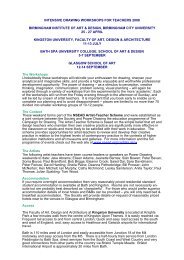Inclusion, Diversity and Globalisation - The National Society for ...
Inclusion, Diversity and Globalisation - The National Society for ...
Inclusion, Diversity and Globalisation - The National Society for ...
- No tags were found...
Create successful ePaper yourself
Turn your PDF publications into a flip-book with our unique Google optimized e-Paper software.
08 Secondary: <strong>The</strong> British Museum: inspiring art09British Museum Poster: Inspiring Art112 134 510 112 316 17 18 19<strong>The</strong> British Museum’s potential <strong>for</strong> exploring the human <strong>for</strong>min world art is unsurpassed. Here is just a taste of the diversityof the Museum’s collection: the abstract, the idealised <strong>and</strong> thenaturalistic, 2-D <strong>and</strong> 3-D images, carved, moulded <strong>and</strong> cast, instone, ceramic, metal <strong>and</strong> on paper. Sculptor Marc Quinn’swords are a testament to the Museum’s contemporaryrelevance: “My sculpture of Alison Lapper on TrafalgarSquare’s Fourth Plinth was part of a series inspired by being inthe British Museum <strong>and</strong> seeing how people reacted tofragmented Greek sculptures, with their limbs missing. <strong>The</strong>ysaid how fantastically beautiful they were, the greatest evermade, but if someone the same shape had come into the room,like Alison, they would have been embarrassed.”614 1578 9Key to poster:1. Utagawa Kuniyoshi (1797-1861). <strong>The</strong> Chinese warrior YanQing (detail). Colour woodblock print. Japan, c. 1827-1830.Loaned by Professor Arthur R. Miller (10044)2. Stella Steyn (1907–1987), Schematic figure, lithograph <strong>and</strong>relief print on pink tissue paper, c.1933. © Estate of StellaSteyn, courtesy of the Gorry Gallery, Dublin3. St<strong>and</strong>ing male <strong>and</strong> female pottery figurines. Mexico,200 BC–AD 5004. Ivory statuette of the Virgin <strong>and</strong> Child. Paris, France,c. 1310–13305. Nkisi figure made of wood, iron, nails, string, cloth <strong>and</strong>fibre. Democratic Republic of Congo, Late 19th/early 20thcentury6. Ancestral male figure with tattooed face <strong>and</strong> inlaid haliotisshell eyes. New Zeal<strong>and</strong>, date TBC. Mid 19th century7. Tile depicting a female figure holding a bottle; ceramic,‘Kubachi’ ware; polychrome underglaze painted fritware,Iran, ca. 17008. Brass head of a ruler with a beaded crown. Ife, Nigeria,14th–early 15th century AD9. Silver votive offering in the shape of a h<strong>and</strong>. Syria, 20thcentury10. Painting on paper of a lady st<strong>and</strong>ing by a flowering tree.India, late 18th century11. Porcelain figure of Budai Hesheng. China, Ming Dynasty,148612. Colossal right foot made of marble. Roman, found nearNaples, 1st–2nd century AD13. <strong>The</strong> auspicious marks on the feet of the Buddha. From thestupa at Amaravati, southern India, 2nd century AD14. Painted wooden board of a figure. Papua New Guinea,20th century15. Red-figured amphora with twisted h<strong>and</strong>les. Greece,c. 480 BC.16. Feather god head. Hawaiian Isl<strong>and</strong>s, early 18th century17. St<strong>and</strong>ing figure of the goddess Tara. Sri Lanka, 8th–9thcentury AD18. Marble figure of a woman, Cyclades, Greece, about2800–2300 BC19. Michelangelo (1475–1564), Study <strong>for</strong> Adam in the fresco onthe vault of the Sistine Chapel, red chalk, c. 1511Except where stated, all photographs are © <strong>The</strong> Trustees of theBritish Museum<strong>The</strong> British Museum is launching a range of new taughtprogrammes <strong>and</strong> resources to support art <strong>and</strong> design atsecondary level <strong>and</strong> at AS/A2. Programmes include freegallery-based workshops combining discussion withmaking activities. <strong>The</strong> workshops will explore themes suchas Identity, Environments, Collections <strong>and</strong> Sketchbooks.Students will be encouraged to explore objects contextuallyas well as to make links with contemporary practice <strong>and</strong>society, so developing their ability to think laterally. Onlineresources will provide ideas <strong>for</strong> making the most of a visit tothe Museum <strong>and</strong> include downloadable presentations ondifferent themes <strong>and</strong> topics <strong>for</strong> classroom use. You can alsofind out about study days <strong>for</strong> older students <strong>and</strong> privateviews of new exhibitions. www.britishmuseum.org/schoolsBook reviewAfricanCaribbeanPupils in ArtEducationby Paul DashAfrican Caribbean Pupils in Art EducationPaul Dash, Sense Publishers, Rotterdam, 2010,xvii + 223 pages, ISBN 978-94-6091-048-7This is a pioneering, hard-hitting book whichoffers no easy solutions to some of the mostprotracted issues relating to race <strong>and</strong> education inthe art <strong>and</strong> design classroom, faced by both pupils<strong>and</strong> teachers. This work is clearly focussed on asingle theme, the learning of African Caribbeanpupils in art <strong>and</strong> design classrooms in the UnitedKingdom. <strong>The</strong> author brings to this study a wealthof personal experience <strong>and</strong> reflection about theclassroom. He also offers us the results of a surveyof children’s <strong>and</strong> teachers’ experiences which heundertook to exp<strong>and</strong> his <strong>and</strong> our underst<strong>and</strong>ingof the dynamics involved in multicultural <strong>and</strong>ethnically diverse classrooms, especially oneswhere black pupils <strong>for</strong>m a significant majority.He also offers the reader some valuable resourcematerials <strong>and</strong> references that should enrich thesyllabus <strong>for</strong> all pupils.<strong>The</strong> author’s basic premise is that the slavetrade had a deeply damaging impact on thecultures of those who experiencedtransportation. As Dash writes, ‘the rupture ofthe slave trade has had a lasting often negativeeffect on the way they elaborate a sense of self <strong>and</strong>position themselves in the world’. As a resultAfrican Caribbean cultures, deniedrepresentation, have become invisible. Dashlikens the slave trade to the Big Bang, an eventwhich echoes through the generations <strong>and</strong> stillhas a lasting legacy. Dash employs KamauBraithwaite’s concept of the ‘absence of ruins’ tocharacterise the artistic difficulty that AfricanCaribbeans face in seeking their cultural identity.This is particularly the case <strong>for</strong> the visual arts,where the link with Africa is virtually erased. <strong>The</strong>author cites CLR James’ blunt statement, ‘We areBlack in skin, but the African civilization is notours. <strong>The</strong> basis of our civilization in theCaribbean is an adaptation of Westerncivilization’. But, Dash argues, despite theircontinual contribution to the development ofBritish imperial wealth, African Caribbeansremain, in an important symbolic sense,strangers or outsiders ‘looking into a differentworld of representation to which they are obligedto find an accommodation’. It is a world in whichmany black students feel ambivalent, <strong>and</strong> being‘Black British’ remains <strong>for</strong> them problematic bothat school <strong>and</strong> in the wider world of cultural <strong>and</strong>political identity. Dash warns the teacher thatthese pupils may have scant interest in theCaribbean let alone Africa, <strong>and</strong> ‘Cuba is as alien tothem as Russia or Kurdistan’. What they reallyvalue is the recognition of Black achievement <strong>and</strong>how this contributes to their own self-esteem.<strong>The</strong> author has a high distain <strong>for</strong> some of thenostrums operating today in schools to fostermulticulturalism. He has a particular dislike ofBlack History Month. As one of his intervieweescomments, ‘Black History Month isn’t muchabout black history’. Dash explains, Black HistoryMonth isolates black presence <strong>and</strong> makes itirrelevant, ghettoised. A few iconic figures arecelebrated but the larger hidden history of blackstruggle is neglected.Does this all mean that innovation incurriculum <strong>and</strong> meaningful pupil experience arecondemned to waste? Far from it. Dash makes thecase <strong>for</strong> African Caribbean students as therepresentatives of a new <strong>for</strong>m of hybrid, creolisedculture. ‘<strong>The</strong>y are living exemplars of ourpost-modern state’. As such they may make workin the art classroom which is outside teachers’cultural experiences, but, Dash argues, it is in anissues-based pedagogy that future progress <strong>for</strong>the African Caribbean student lies. <strong>The</strong> authorsuggests that the black body represents <strong>for</strong> suchstudents a unique <strong>and</strong> potent source of expressivepossibilities. Whether it be in <strong>for</strong>ms of walking,clothing or hair styling, new syncretic <strong>for</strong>msenable young people to create new expressivestyles that are decidedly aesthetic, fun <strong>and</strong> seriousmarkers of identity.<strong>The</strong> ‘absence of ruins’ provides cultural space<strong>for</strong> new art <strong>for</strong>ms, whether it be the historicinventions encapsulated in Maroon combsdesigns, the Caribbean Surrealists, Lam <strong>and</strong>Greaves, the Caribbean Artists’ Movement of1966-1972, or the abstraction of Frank Bowling’spaintings celebrated in Rasheed Areen’s splendidexhibition catalogue entitled <strong>The</strong> Other Story.<strong>The</strong>re is now, Dash reminds us, a vibrant recentart history <strong>for</strong> pupils to explore, interrogate <strong>and</strong>even emulate. INIVA <strong>and</strong> Autograph provide avery valuable <strong>and</strong> accessible entry tocontemporary art such as the photography ofIngrid Pollard, the painting of Sonya Boyce <strong>and</strong>Gavin Jantjes <strong>and</strong> the barbershop art of FaisalAbdu’ Allah. Despite the restrictive culture of theexamination syllabuses, there is a world of newartistic practice available <strong>for</strong> pupils to explore inthe classroom. And, Dash reminds us, there areboth MA <strong>and</strong> higher degree programmes now <strong>for</strong>teachers to engage with to help them deliver apedagogy that respects <strong>and</strong> promotes art relevantto the African Caribbean pupil, <strong>and</strong> incidentally,to all of us involved in exploring a postmoderncurriculum.This an excellent <strong>and</strong> challenging account <strong>and</strong>analysis. I hope that, when reprinted, thepublishers will attend to better illustrations <strong>and</strong>an index.Nick Stanley, Research Fellow,Department of Africa, Oceania <strong>and</strong> the Americas,<strong>The</strong> British Museum


